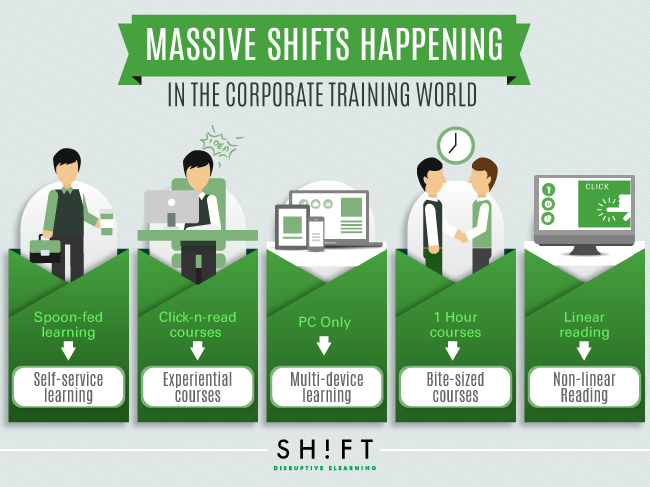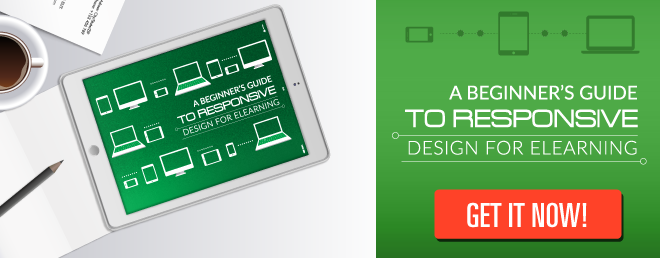Embrace the race or get left in the dust. While the world of e-learning design might not seem as fast paced or ever-changing as other environments, it is still a business, and there are changes in motion that designers need to be aware of to to stay relevant in the field. In the same way, that education has begun to leave the classroom and is now accessible from mobile devices, technology is still evolving to make the new learning arena better, faster and more widely accessible. Companies now have options they never did before for providing training. Being aware of these changes means keeping your courses relevant for students and keeping your design skills in demand.
So, what are the biggest changes in the corporate training world right now and why should your know about them?

1) Spoon-fed Learning to Self-service Learning
We are in the middle of the “Self-service” revolution, where people prefer to “do it themselves” because it lets them gain control over the things they do, that was previously not attainable. Technology has made it more possible than ever to make learning about the students versus about the teacher or the content they present. Students can now access information and learn how they want to without having to wait to for an instructor to present it to them.
With this shift to leaner-focused training, content is becoming less relevant than it once was. While content in a course still needs to be accurate and complete, great content is not enough to make training great. The measure of a course’s effectiveness is found in how well it gets through to students.
What do Learners Want?
First and foremost, learners want flexibility, not rigid programs that require them to adapt to the program, and here are some ways you can offer that to them:
- Corporate learners lead busy lives and the option to request extensions for coursework will be greatly appreciated.
- The option to speed up the completion of a course wherever and whenever possible.
- Many corporate learners will have prior knowledge and will want to be able to use it. Giving tests to determine prior knowledge and the chance to skip over sections will keep more advanced learners from getting bored.
What all these changes boil down to is increasing the success of your eLearning courses, which can be measured in how much they help students learn. If you ever find yourself wanting to slip back to the old ways of hour-long lessons with pages and pages of text think about your audience and how they’ll feel reading.
2. Click-n-read Courses to Experiential Courses
Learning is not a spectator sport; students learn very little listening to audio, memorizing content, and recalling answers. Active learning, experiential learning, and social engagement are all becoming increasingly important. They allow students to become involved in their learning, relate the content to their own experiences, and apply it to their daily lives.
In the past, teachers had to beg, threaten and cajole students into participating. Now, with technology, it is just as likely, if not more likely, that students are the ones demanding the ability to participate and feel in control of their own learning.
This includes being able to learn how and when it is convenient to them. An instructor for a course like this takes on the role of a guide students can turn to when they need to as opposed to standing in front of a class and lecturing for hours on end.
Incorporating available technology encourages this kind of deeper understanding of the material as learners become able to interact and contribute to how problems are solved. With tools like web conference and the various ways that information can be discussed via forums and social media, experiential learning is fully possible in a remote environment and is a growing trend that can’t be ignored.
It's time eLearning professionals stop believing that learning only occurs when students show signs of visible activity on a course. In fact, active or experiential learning can be hidden from the instructor’s view and visual learning may be passive. Consequently, a better indicator of active learning is a student questioning content and developing his or her own interpretations. Learners may write about information, relate it to their personal experiences, or apply it to their daily lives.
3. The Way Students View a Course: PC-only to Multi-device learning
The era of the mobile device is in full swing with smartphones leading the charge to a new way of learning and accessing data. However, desktops, laptops, and tablets are also still in play, which is part of what makes a designer’s job more difficult because students often don’t stick to one device. While a phone might be the dominant device, the others are also likely to be used by the same user.
Because of this change in how learners and workers view courses, there is an increasing demand to have courses available on a wide range of screen sizes. Today’s learners expect a complete learning experience. People are using all their devices to work and learn. Therefore, your courses need to be responsive to these varying screen sizes and multi-device requirements.
It is also increasingly popular for companies to have workers use their own devices for training (BYOD wave). This is not only a cost savings for the company but more convenient for workers who don’t have to carry an additional device with them. It also reduces the amount of time it takes to get everyone up to speed on using an app or program when they are familiar with the device they are using. .
This is in line with our increasing need for convenience and rapid access to information. Anything that forces you to use one device over another can easily seem outdated. Learners will more easily tune out information that doesn’t seem up-to-date and your course will become less effective. What constitutes a mobile device is also changing and expanding as things like wearable devices become more widely available. Keeping up with current trends will make it easier to adapt to newer devices later.
4. 1-hour Courses to Bite-sized Courses
Today, it is still pretty standard to have a course that is designed to take somewhere from 30 minutes up to several hours and be intended for a single sitting. This type of course typically includes long blocks of texts, some quizzes and occasional graphics scattered throughout the course. While learners are usually used to seeing this format and familiarity can be a good thing, this style of teaching presents several problems.
That lengthy text can be a real pain to get through on a small screen. What might only be a few pages of text on a computer screen can approach a hundred or more swipes of the screen on a mobile phone so unless you want your students to remember your course for the sore pointer fingers it gave them, you’ll want to look into shorter, bite-sized courses.
What makes a bite-sized course work?
Bite-sized courses take important information and break it down into short individual lessons. This keeps the information centralized so learners can access it easily and, more importantly, quickly. When creating these 5 (give or take) segments use concise wording, and relevant graphics and infographics.
If you’re still struggling with the idea of chopping down your long, word-heavy courses take a minute to consider how you learn and read. When you see a long article do you read it in more than one sitting? Do you ever click on links or get distracted while reading it? It’s likely you answered yes to both of those questions and modern learners are the same. It often doesn’t matter how important the course is, the fact remains that people simply don’t have the time or attention span to read dense text.
Read: The Age of Bite-sized Learning: What is It and Why It Works
5. Moving from Linear to Non-Linear Courses
With the possible exception of binge watching the latest season of Orange is the New Black on Netflix, people, on average, have shortening attention spans with a recent study showing that the average attention span has been whittled down to a mere 8 seconds. This is largely thanks to a lot of the technology we designers are now trying to incorporate into our courses, such as hypertext that encourage learners to click on a link without fully reading the page they are currently on. This type of reading is considered nonlinear where pages are no longer read from top to bottom, but instead we jump around from one area to another.
This is in line with our “on-demand” world. Education and training are not exempt from the trend of audience’s wanting instant information and self-directed services. We access things faster and skim for relevant information as our brains adapt to technology.
Specifically, technology has provided new devices designed for reading content that includes scrolling options that allow for faster skimming and scanning. Now, instead of linear reading which continued to dominate through most of the 20th century, readers have the option to not only jump around within content but to save things they want to read later, save indefinitely and highlight for quick reference. Older technology simply didn’t allow for this flexibility.
So if you are still designing linear eLearning courses, stop. Learning in life situations is a non-linear process — such learning occurs at random intervals when one’s attention is captured by the need or desire to increase knowledge. eLearning provides the perfect opportunity to mimic this real life learning process by providing training in the way humans would naturally obtain knowledge outside a training or educational environment.
Interesting read: Serious reading takes a hit from online scanning and skimming, researchers say
The most successful trainers and leaders will be those that are adapting to change. What are you waiting for?



